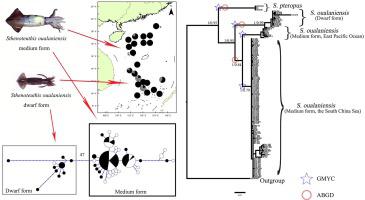当前位置:
X-MOL 学术
›
Mol. Phylogenet. Evol.
›
论文详情
Our official English website, www.x-mol.net, welcomes your feedback! (Note: you will need to create a separate account there.)
Phylogenetic relationships and cryptic species in the genus Sthenoteuthis (Cephalopoda: Ommastrephidae) in the South China Sea.
Molecular Phylogenetics and Evolution ( IF 4.1 ) Pub Date : 2020-05-05 , DOI: 10.1016/j.ympev.2020.106846 Lei Xu 1 , Ping Liu 2 , Xuehui Wang 1 , Kay Van Damme 3 , Feiyan Du 1
Molecular Phylogenetics and Evolution ( IF 4.1 ) Pub Date : 2020-05-05 , DOI: 10.1016/j.ympev.2020.106846 Lei Xu 1 , Ping Liu 2 , Xuehui Wang 1 , Kay Van Damme 3 , Feiyan Du 1
Affiliation

|
Large squids of the genus Sthenoteuthis are commercially relevant species that include two truly oceanic squids. They are large nektonic predators being widely distributed throughout tropical and subtropical waters of the Atlantic and Indo-Pacific Ocean. The present study investigates different morphs varying in size at maturity, and assesses the genetic divergence in Sthenotheutis in relation to geographic patterns in the South China Sea. We obtained sequences using a mitochondrial (cytochrome c oxidase subunit I) and a nuclear (Histone H3) gene marker from 111 individuals in 23 locations of the South China Sea. In combination with sequences available in public databases, we performed tests on DNA taxonomy, mostly based on molecular phylogenies. Our results suggest that the genus Sthenoteuthis includes at least three species. The Indo-Pacific purpleback squid Sthenoteuthis oualaniensis contains at least two genetically distinct lineages that can be considered separate species, a dwarf species and a medium-sized species, separated by both the mitochondrial marker and the more conserved nuclear marker. We also assessed whether the few cases of mitonuclear discordance could be the result of genetic introgression and past hybridization or incongruence lineage sorting. The medium-sized species is more widely distributed and dominant in the South China Sea than the dwarf species. The medium-sized species inhabits the whole South China Sea, whereas the dwarf species is restricted to the equatorial waters of the South China Sea. The medium-sized species has two further genetic clades, one distributed in the East Pacific Ocean and the other in the South China Sea. This high level of genetic differentiation is in agreement with the discriminant analysis on the morphological measurements, clearly separating the dwarf and medium-sized species, indicating the presence of a complex of pseudo-cryptic species in S. oualaniensis, clearly identifiable by differences in DNA sequences and in body size, and statistically differentiated in their body measurements.
更新日期:2020-05-05



























 京公网安备 11010802027423号
京公网安备 11010802027423号